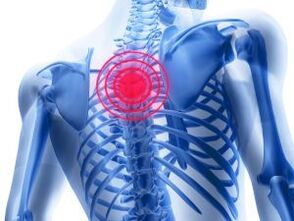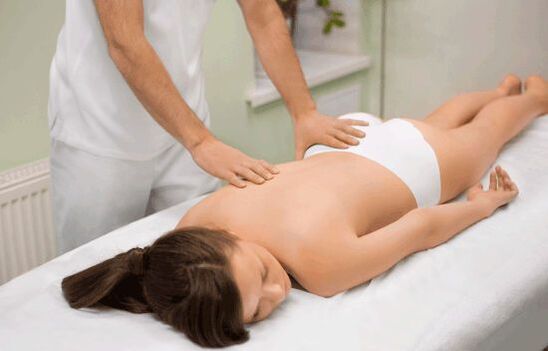
Clinically, chondrosis is manifested by acute, penetrating or dull pain, aching, crunching and clicking sound when bending over, stiffness.
As for pathology, the characteristic symptoms and many specific symptoms are a feeling of lack of air when inhaling, discomfort in the heart area, and even a sore throat.
Treatment of the disease is mainly conservative with pharmacological drugs. Physiotherapy procedures, massage sessions are also performed and chiropractic machines are used.
If such treatment is not effective, the patient is indicated for surgical intervention.
Details of symptoms
Symptoms of osteonecrosis of the thoracic spine never appear simultaneously. At the initial stage of the development of this degenerative-dystrophic pathology, only mild discomfort in the back is noted. Patients drink to relieve fatigue after a tiring day of work, reduce the "stiffness" of the muscles due to lying in one position for a long time.
But the intensity of the discomfort increased gradually, steadily. The discomfort is replaced by intense pain, complicated by limited range of motion, dizziness, and headaches. In medicine, all the symptoms of osteonecrosis of a certain site are divided into several groups. This helps to diagnose faster and determine the treatment strategy.
On a note!Symptoms of thoracic osteonecrosis in men and women do not differ in characteristics, severity, or location. But in men, they can arise a little later due to stronger musculoskeletal system. In addition, some men experience erectile dysfunction against the background of osteonecrosis.
Vertebral symptoms
Under the influence of unfavorable factors (hypothermia, increased physical activity), the long-term remission of thoracic osteonecrosis can be interrupted by a sudden acute pain. Even more often, it is provoked by staying in one position of the body for a long time, such as in a sitting position. If a person stands up suddenly, then there will be sharp pain in the back to the point of loss of mobility for several minutes.
In medicine, this condition is called dorsago. It differs from ordinary pain in its concomitant symptoms:
- feeling of lack of air when inhaling;
- heavy hard.
The course of the pathology is often complicated by back pain - pain in the thoracic spine, increasing in intensity. It increases when bending, turning the body to the sides. In order not to be in pain, a person has a forced posture. At the same time, he inadvertently tensed his back muscles, inadvertently provoking their excitement. Now they also start to hurt, especially when walking.
Extravertebral symptoms
As bone degeneration in the chest develops, the discs become thinner and break down. These cartilage cushions can no longer distribute the generated load, eliminating the impact of the vertebrae against each other. A compensatory response of the body is activated - the bone structure begins to deform along with the formation of tumors. They press on sensitive nerve endings, invading the spinal canal. Therefore, there are specific symptoms of osteonecrosis of the rib cage in women and men: loss of sensitivity of certain parts of the body, a burning sensation and "goose bumps".
Important! Osteoma of thoracic localization is most often manifested by a dry, unexplained cough, sore throat, a feeling of coma in it, as well as urinary disorders.
But that's not all. Spinal roots are responsible not only for the internal development (transmission of nerve impulses) of the spine, but also for internal organs. Therefore, when they are violated, there will be unpleasant sensations from the liver, kidneys, gastrointestinal tract, heart muscle. Non-specific signs of back disease presenting with thoracic osteonecrosis:
- pain in the heart area, like recurrent angina, shortness of breath, feeling that the heart is "squeezing";
- panic attacks, psychological instability, irrational fears, anxiety, sleep disturbances;
- discomfort in the epigastrium, intermittent nausea, sometimes leading to vomiting, belching, abdominal distension, boiling and gnawing in it;
- peristalsis disorders - constipation or diarrhea;
- long, labored breaths with sobs.
The pain is not localized directly to the site where the disc has been destroyed and (or) a herniated disc has formed. They radiate along the path of the nerve. Signs of thoracic osteonecrosis can be disguised as renal colic, symptoms of gastritis, peptic ulcer, hepatitis, pancreatitis, cholecystitis, and even gastroenteritis.
Marrow disease
This is the name of the extravertebral syndrome, which is rare in clinical practice. It is observed in 3-4 stages of the disease, when due to instability of the vertebral segment, the nucleus pulposus protrudes beyond the annulus. Herniated discs form, continuously putting pressure on the spinal cord. At an appointment with a chiropractor or neurologist, the patient complains of frequent groin pain radiating to the groin area. At the same time, there is a feeling of weakness and numbness in the lower extremities.
Against the background of the invasion of the spinal cord, the interior is severely disturbed. In the absence of treatment, the functional activity of the organs located in the small pelvis will decrease. Compressive myelopathy causes problems with bowel movements. And because the diameter of the spinal canal is markedly narrowed, the sensitivity of the legs is reduced. In severe cases, the patient is diagnosed with paralysis (partial or complete paralysis) of one or both lower extremities.
Remission of symptoms
Apart from the recurrences, osteonecrosis of the chest hardly bothers a person. Occasionally, there is a dull, aching, pulling back pain, which usually goes away after a long period of rest. But it is worth at least slightly increasing the load on the spine, lifting a heavy object or bending over, as after the next relapse. It can be triggered by factors such as:
- stressful situations, depressive states;
- hypothermia, sudden temperature changes;
- stretching in one position of the body;
- alcohol abuse;
- unbalanced diet, lack of food with a lot of calcium, phosphorus, manganese, molybdenum in the diet.
Sometimes remission ends because a person tries to avoid another relapse. He goes to a chiropractor or massage therapist with a dubious reputation or little practical experience. Attempts to stretch the spine lead to another exacerbation.
The main methods of treatment
The disease cannot be completely cured, so all efforts of doctors are aimed at improving the patient's health. Patients are recommended to wear orthopedic products (bras, bandages) to immobilize the vertebral structures, preventing their displacement. Drugs of different clinical and pharmacological classes are prescribed, physiotherapeutic measures and physiotherapeutic exercises are performed.

The movements of the chiropractor's hands are aimed at increasing the distance between the vertebrae, reducing the process of bone degeneration in the chest.
Important!With high degree of thoracic osteonecrosis, conservative treatment is futile. The patient was immediately recommended for surgical intervention - excision of the herniated disc mass, joint puncture, implant placement in the damaged disc site, bone grafting.
Drug treatment
Treatment of thoracic spondylosis is aimed at eliminating all symptoms, inhibiting destructive and degenerative processes. During the exacerbation period, parenteral solutions are used, which take effect after 5-10 minutes. After that, the results are consolidated by taking a tablet preparation, applying ointments and gels. In the stage of remission, mainly external agents are used, which act more gently on the body.
Non-steroidal anti-inflammatory drugs (NSAIDs)
This is the most commonly used group of drugs in the complex treatment of osteonecrosis of the chest. Their active components block the biosynthesis of pain, inflammation and fever mediators from arachidonic acid. Even after a single use of an NSAID, a person's health improves dramatically:
- the severity of pain syndrome decreases;
- the annoying crackling sound that occurs when the body rotates and tilts disappears;
- inflammatory processes in soft tissues weaken, edema resolves;
- range of motion in the thoracic region increases.
To prevent recurrence, intramuscular solutions are used. Preparations in the form of capsules or tablets can cope with moderate pain. And ointments and gels quickly eliminate mild discomfort.
Preparations with vitamin B
Preparations with vitamins of group B cope well with internal disorders, improve the transmission of nerve impulses to the central and peripheral nervous system, stimulate the restoration of damaged spinal roots. The composition of the fund is represented by thiamine, riboflavin, pyridoxine, cyanocobalamin.
During the first week of treatment, intramuscular injections are carried out with drugs that, in addition to vitamins, contain lidocaine, which instantly eliminates pain. And then, for a month, the patient was shown taking the pill.
Glucocorticosteroids
The use of these synthetic analogues of hormones, produced by the adrenal glands, is done when safer measures have not worked. Glucocorticosteroids are prescribed to patients with acute, penetrating low back pain that radiates to internal organs. Medications can be taken by mouth, but they are usually given by injection, including in areas where the disc has been destroyed.
Glucocorticosteroids have many contraindications and potential side effects. Long-term hormone therapy for thoracic spondylosis leads to damage to tissues of the liver, kidneys, and stomach. Therefore, their use is prohibited in patients with cirrhosis of the liver, peptic ulcer disease, renal failure and osteoporosis.
Muscle relaxants
Back pain is often caused by increased musculoskeletal tone. For relaxation, muscle relaxants are used - first in the form of a solution for injection, then in the form of tablets. The drug reduces muscle spasms that cause compression on the spinal roots. Which muscle relaxant is most effective?
- prevent polyarticular reflexes;
- relax muscle spasms;
- reduce the release of prostaglandins.
The drug is rarely used as monotherapy. Treatment of thoracic fibrosis is performed with muscle relaxants in combination with glucocorticosteroids or nonsteroidal anti-inflammatory drugs. Their significant drawback is the rather rapid formation of addiction, so it is forbidden to use them for more than a week.
Chondroprotectors
Unlike drugs that eliminate the symptoms of osteonecrosis of the chest, these drugs are also used to treat hereditary diseases. This is the only class of drugs that can increase the production of chondrocytes, which are necessary for partial restoration of cartilage discs. All the therapeutic effects of chondroprotectors are due to the high content of glucosamine and/or chondroitin.
But not only for disk resiliency, chondroprotectors are appreciated. Their components glow in the area of the damaged vertebral segment. After 2-3 weeks, maximum therapeutic concentrations of glucosamine and chondroitin are produced. Now the drugs are beginning to show marked analgesic, anti-inflammatory, anti-edematous activity.
Introduction!Osteonecrosis should be treated with chondroprotectors in the form of a solution for injection or tablets. Despite all the manufacturers' guarantees about the effectiveness of ointments and creams, they cannot provide an evidence base for their therapeutic efficacy.
Non-drug treatment
Treatment of osteonecrosis of the thoracic region with pharmacological drugs is necessarily combined with regular physical education. Exercise therapy is the most effective method of preventing disability. Thanks to daily practice, the back muscles and thoracic ligaments are strengthened, the production of synovial fluid that feeds the vertebral structures is improved. The set of exercises is determined by the exercise therapist after studying the results of the diagnosis with X-rays. He is present at the first classes, monitoring the loading dose.
Manual osteolysis is also performed, which aims to increase the distance between the discs and the vertebrae. Perform dry or underwater traction (traction) of the spine, and at home - hang on the bar. The effectiveness of manual therapy is increased when physical therapy is performed simultaneously:
- electrophoresis;
- laser therapy;
- acupuncture therapy;
- ultraviolet ray;
- diadynamic current.
Patients are assigned 10-15 sessions of classical, vacuum, Scandinavian, reflexology. Also useful are hirudia therapy, acupuncture, spa treatments with radon and hydrogen sulfide baths.
Only with the help of an integrative approach to the treatment of thoracic osteonecrosis can further disc damage and vertebral deformity be ruled out. Compliance with the recommendations of the doctor helps to eliminate all symptoms of chronic pathology as soon as possible.












































